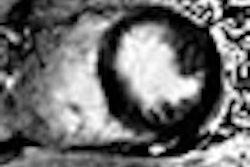CHICAGO - Researchers suggest that diagnosing suspected breast cancer with Naviscan PET Systems' high-resolution PET scanner has the potential to reduce the incidence of false positives when compared to MRI.
The key finding of the study, presented at the 2008 RSNA conference on Tuesday, was that positron emission mammography (PEM) false positives were reported 18% of the time compared to a false-positive rate of 33% with MRI, said Dr. Kathy Schilling, director of breast imaging and intervention at the Center for Breast Care at Boca Raton Community Hospital in Florida.
"We believe that with the use of positron emission mammography, fewer women will be called back for additional tests and biopsies, which is emotionally traumatic for the patient as well as the family," said Schilling.
Because of the small number of women tested by the two modalities, the differences in results failed to achieve statistical significance, Schilling said. However, she said that as the technique continues to be tested, the likelihood is that the difference will become statistically significant.
In the study, 182 women with breast cancer underwent both PEM and breast MRI. Both techniques proved 89% accurate at spotting the malignancies.
The mean age of the women was 59 years and a total of 167 suspect lesions were identified. Of those lesions, 30 were ductal carcinoma in situ (DCIS), and PEM detected 27 DCIS lesions versus 25 detected by MRI. Positron emission mammography spotted all four of the early, tiny invasive tumors less than 5 millimeters in diameter, while MRI found three of those potentially dangerous tumors.
Schilling said that PEM is not affected by either breast density or a woman's hormonal status, conditions that can impact the ability to successfully read an MRI scan. "Unless breast MRI is performed on days 7 through 14 of the menstrual cycle, reading images is extremely difficult," Schilling said. "With PEM, we don't have that problem."
The new technique also offers relief from the enclosed, claustrophobic feel of the MRI device, in which a patient is rolled into the tubelike structure of a conventional MRI. Schilling said the PEM scans are performed at patient stations that are more open; during PEM, a woman sits upright and has freedom to move around a bit, she said.
Currently, positron emission mammography is only available at about 30 sites in the U.S., and a unit costs about $850,000.
The use of PEM appears promising, said Dr. Joseph Tashjian, president of St. Paul Radiology in Minnesota, but it would be premature to make broad statements about its utility. "More studies are needed," he said.
Tashjian, who moderated an RSNA press briefing, said that PEM and other emerging technologies such as breast-specific gamma imaging target smaller lesions.
Schilling disclosed that she has financial relationships with San Diego-based Naviscan.
By Edward Susman
AuntMinnie.com contributing writer
December 3, 2008
Related Reading
Naviscan touts PEM trial data, June 17, 2008
PEM performs well against breast MRI, whole-body PET, June 6, 2007
PEM turns in solid results for detecting breast malignancies, November 10, 2005
PEM development picks up pace, February 7, 2005
Copyright © 2008 AuntMinnie.com




















